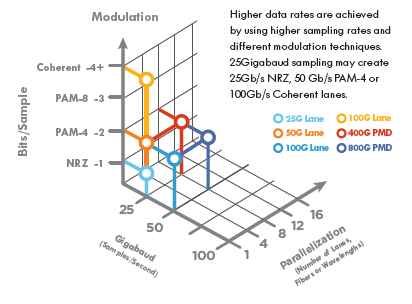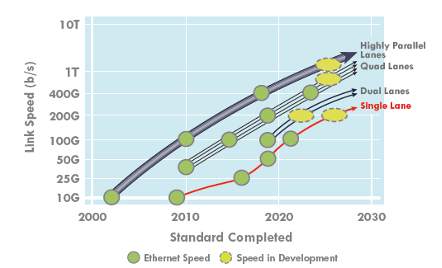With advancements in underlying technologies such as 5G networks, storage media, and computing power, data centers are poised to achieve unprecedented levels of throughput. Large enterprises, especially those in the internet industry, have an increasing demand for Ethernet with high speeds, large bandwidth, low latency, and low power consumption.
Cisco, a leading company in the industry, has developed the first 800G data center switch, which has been officially released. After conducting a series of tests, including 100% line-rate forwarding and traffic flow verification, the results have shown that this switch is highly adaptable to high-capacity switching chips, high-speed interfaces, and high-capacity interconnection solutions. According to the 5-Year Ethernet Switch Data Center Forecast report published by the renowned research firm Dell’Oro Group, the compound annual growth rate of the global data center Ethernet switch market is expected to be close to double digits from 2021 to 2026. The cumulative spending in this field is projected to reach nearly $100 billion over the next five years. 400Gbps and higher speeds will account for half of the market share, with 800Gbps surpassing 400Gbps by 2025. This breakthrough in capacity will lead the industry into the era of 800G transceivers in data centers.
Traditional Optical Transceivers
A traditional optical module is a device that packages discrete components such as III-V semiconductor chips, electrical chips, and optical components. It essentially modulates and receives optical signals to achieve optoelectronic conversion. In contrast, silicon photonics technology utilizes laser beams instead of electronic signals for data transmission. Silicon photonics integrates optical devices and electronic components into a single, independent microchip, enabling deep integration of optical signal processing and electrical signal processing. This transformation shifts from the “electrical interconnection” of traditional optical modules to true “optical interconnection”.
Advantages of Silicon Photonics Transceivers
Silicon photonics integration offers several advantages, including high bandwidth, low power consumption, and high integration density. However, the most significant advantage is its cost-effectiveness. In a typical optics module, the cost of the optical chip accounts for about 40%, and the cost of the laser accounts for around 20%. If the cost of lasers, which represents 75% of the cost, can be reduced, it can lead to a 15% reduction in the overall cost of the optics module. With the adoption of silicon photonics technology in the module, the cost of the chip will also experience a substantial decrease due to the high integration of modulators and passive optical paths on the chip. As optics modules evolve towards 400G and 800G transceivers, the cost and technological advantages of silicon photonics modules will gradually become more prominent.
Standard of 800GBASE-R
The latest 800GBASE-R standard introduces modifications to the existing 400GbE logic framework in order to distribute data across 8 physical channels operating at 106Gbps each. This means that, technically, the transmission rate is faster than 800G transceivers. The main objective of this new standard is to achieve maximum speed requirements with minimal cost. Compare with the 400G standard, the 800G standard includes two new specifications: Media Access Control (MAC) and Physical Coding Sublayer (PCS). Based on the 800G transceivers standard, there are currently two main types of optical modules in the market:
- 800G-SR8: This is an 8x100G optical module designed for short-range (SR) applications. It utilizes a single-mode fiber solution and can achieve link distances ranging from 60 to 100 meters.
- 800G-FR4: This module is of the 4x200G type and requires a new Forward Error Correction (FEC) mechanism.

1.6T Ethernet
With the increasing demand for data-intensive applications and users’ continuous pursuit of speed, the market and technology are constantly innovating, and soon there will be industry standards for 1.6T Ethernet data rate. In the research of 1.6T Ethernet technology, there are several points to note from a technical perspective. Firstly, it is important to ensure optimal performance when integrating PMA (MAC, PCS, and Physical Medium Attachment). Secondly, compatibility with sublayers from different vendors must be considered to avoid any impact on interoperability. Thirdly, there will be multiple configurations for 1.6T Ethernet, and choosing the most suitable configuration scheme that aligns with the needs of the majority is crucial. Initially, the 1.6T design will be based on 100G SerDes, requiring the PCS to support 16 channels. With the evolution of the 200G SerDes standard, the PCS will need to support PAM4 or PAM6 SerDes. Although the standards for 1.6T Ethernet have not been finalized yet, it is evident that managing massive amounts of data and optimizing connections will require some engineering creativity.

Conclusion
Alongside the surge in internet traffic and rapid growth in bandwidth, the issue of energy consumption in data centers has become more prominent. Energy-efficient and environmentally friendly data centers will inevitably become a trend. Striking a balance and making breakthroughs between high performance and low power consumption will be a challenge. Meeting the demand for green, low-carbon, efficient, high-speed, and cost-effective data centers will also pose a challenge. Moreover, with the widespread adoption of 800G transceivers and the development of 1.6T, as well as the technological iteration of optical modules and switches, if users misjudge the transition time, it can lead to significant cost differences and great difficulties for users.


























